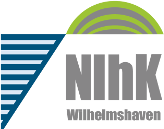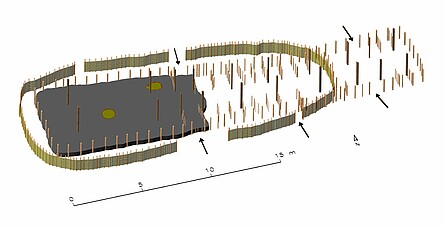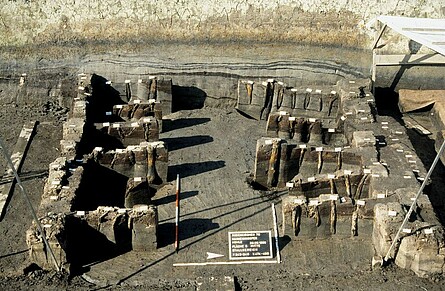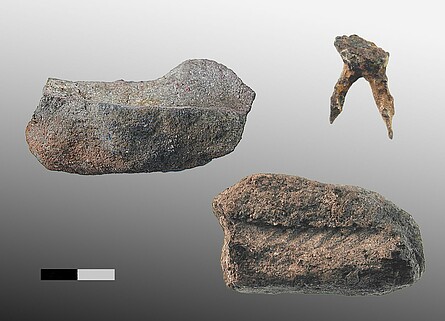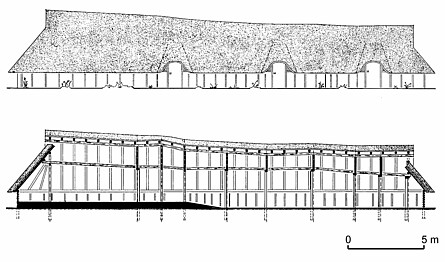The Late Bronze Age Settlement Rodenkirchen-Hahnenknooper Mühle, district of Wesermarsch – The First Farmers in the German Sea Marshes
In 1971, wooden post and other settlement remains were discovered during excavation works in the vicinity of the Hahnenknooper Mill to the west of Rodenkirchen on the Lower Weser. The remains were covered by 2 m of marsh clay which accounts for their excellent preservation. From the initial assessment of the pottery it was evident that the settlement had been occupied during the later Bronze Age; it was therefore the oldest settlement in the German Sea Marshes. A subsequent, extensive programme of augering was carried out with the aim of establishing the settlement’s extent as well as its integration with its environs, and part of the settlement was excavated between 1996 and 2001. These excavations revealed the extremely well preserved remains of a three-aisled byre house of the 10th/9th century BC, enclosed by a fence which had been replaced several times, as well as ancillary buildings. The presence of a bronze smith working in the settlement is attested by clay casting moulds and other finds. The investigations were carried out with financial support of the German Research Foundation (DFG). The detailed analysis of the results of the excavations at Rodenkirchen is currently in its final stages. The project leader, E. Strahl, has presented the results to date in several summary publications. Individual studies on the assemblages of animal bone, botanical remains, arthropods, pottery and worked stone as well as on the settlement’s palaeogeography have already been published (see bibliography); still outstanding are the complete publication of all building remains and a concluding interpretation of the entire excavation record.
Based on the documentation of the byre house, a complete reconstruction has been created by the „Förderverein Bronzezeithaus Hahnenknoop e. V. (Friends of the Bronze Age House Hahnenknoop, reg. charity)“, which can be visited in the immediate vicinity of the site.
Bibliography
Bungenstock, F., 2008: Zur Paläogeographie des jungbronze- bis früheisenzeitlichen Siedlungsplatzes Rodenkirchen-Hahnenknooper Mühle, Ldkr. Wesermarsch. Probleme der Küstenforschung im südlichen Nordseegebiet 32, 181-195.
Goldhammer, J., 2014: Steinreich in der Marsch? Das lithische Inventar der jungbronze- bis früheisenzeitlichen Siedlung Rodenkirchen-Hahnenknooper Mühle, Ldkr. Wesermarsch. Siedlungs- und Küstenforschung im südlichen Nordseegebiet 37, 171-188.
Grimm, J. M., 2003: Untersuchungen an Tierknochen aus der jungbronzezeitlichen Flachsiedlung Rodenkirchen-Hahnenknooper Mühle, Ldkr. Wesermarsch. Mit einem Exkurs zu den Knochengeräten. Probleme der Küstenforschung im südlichen Nordseegebiet 28, 185-234.
Kucan, D., 2007: Archäobotanische Untersuchungen zu Umwelt und Landwirtschaft jungbronzezeitlicher Flussmarschbewohner der Siedlung Rodenkirchen-Hahnenknooper Mühle, Ldkr. Wesermarsch. Probleme der Küstenforschung im südlichen Nordseegebiet 31, 17-83.
Precht, G., 2008: Die Keramik der jungbronze- bis früheisenzeitlichen Siedlung Rodenkirchen-Hahnenknooper Mühle. Probleme der Küstenforschung im südlichen Nordseegebiet 32, 197-241.
Schelvis, J., 2007: Report on the arthropod remains from five Bronze Age samples from Rodenkirchen-Hahnenknooper Mühle, Northwest Germany, Wesermarsch – Validation and detailed analysis. Probleme der Küstenforschung im südlichen Nordseegebiet 31, 85-93.
Strahl, E., 2005: Die jungbronzezeitliche Siedlung Rodenkirchen-Hahnenknooper Mühle, Ldkr. Wesermarsch – Erste Bauern in der deutschen Marsch. In: C. Endlich u. P. Kremer (Red.), Kulturlandschaft Marsch. Natur, Geschichte, Gegenwart, 52-59. Schriftenreihe des Landesmuseums für Natur und Mensch 33. Oldenburg.
